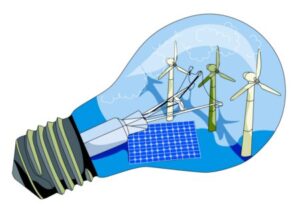Trashing wind blades may seem an unusual topic because designers create Turbine Power Units to be to be very durable. After all, they work very hard as they manufacture clean, efficient electricity. However, everything eventually wears out.
Turbine Wind Blades are no exception. They have a life expectancy of approximately 20-25 years. And many of these have already reached the end of their useful life. And therein lies the problem. What do we do with worn-out turbine blades?
Trashing Wind Blades: What’s So Difficult?

Wind Power Could Open Up More Job Opportunities.
You might ask, what’s so difficult about getting rid of a few wind blades. On the surface, it doesn’t sound like a difficult task. However, a closer look reveals several unusual, if not insurmountable problems.
1. First, is the sheer size.
These wind turbine blades are humongous. They range from 100 to 300 feet long. In case, that doesn’t sink-in, imagine a blade as long as a football field. Of course, not all are that long. Many are only around 200 feet like the wingspan of a Boeing B-747.
Consider the task of finding a truck trailer long enough to haul one of these blades away. Here is a description of actions taken by one company:
Before hauling one of these blades, you “need to saw through the lissome fiberglass using a diamond-encrusted industrial saw to create three pieces small enough to be strapped to a tractor-trailer.”
2. Quantity of Wind Units
The sheer numbers and mass of these blades are awesome and the numbers are growing. Bloomberg News reports that “Tens of thousands of aging blades are coming down from steel towers around the world… In the U.S. alone, about 8,000 will be removed in each of the next four years.”
Predictions reveal that the quantity situation is getting worse, not better. To begin, most of the current installations were built more than a decade ago. at that time, installations were less than a fifth of what they are now.
Additionally, a new emphasis on non-fossil fuels should forecast the likelihood that the number will continue to increase.
3. The Purposely Designed Strength Makes Disposal Difficult.

Clean Energy: Waste Management Systems Strive To Do Their Part As Our Technology Is Refined.
The sheer strength of blades prevents crushing and makes cutting them extremely difficult. According to experts, engineers design the blades were “to withstand hurricane-force winds.”
Achieving the lightweight, efficient, blade requires a special material. At present, that material is a composite mixture of fiberglass. This substance meets all the other standards. Yet it is still strong enough to withstand storms like the above hurricanes. Obviously, this is important to states like ours that face this type of storm problem frequently.
The best waste management solution would be to separate the plastic from the glass fibers. However, the mixed nature of the blade material makes separating the plastics from the glass fibers very difficult and costly. Thus to recycle the aging blades into a workable fiberglass material would be very challenging. The same strength that makes the blades strong also makes them very hard to break apart. In simple terms, trashing wind blades becomes extremely difficult.
Value of Wind Turbine to Produce Electric Power
As difficult as blade disposal appears to be, the potential of wind production units could make it all worthwhile. However, currently, the the truth is that these giant windmills produce only about 7.3 percent of utility-scale electricity.
However, wind power is projected to continue growing across the U.S. through 2050, according to the latest Wind Technologies Market Report. And already, we have examples of the potential value.
Texas Wind Power: Prime Example
In our previous blog on the Texas weather-related disaster, we discussed the impressive power capability of wind generation in Texas. And Texas is the prime example of wind power value.
The state of Texas produces more electricity than any other state. In fact, they produce more than double the amount of our beautiful state of Florida. However, we take pride in being the 2nd most electric productive state in the Union.
Wind: Fastest Source of Texas Energy
It’s not an exaggeration to say that, wind power is the fastest-growing source of energy in the Texas’ power grid. In 2015, wind power generation supplied 11% of Texas’ energy grid. Last year it supplied 23% of the system’s power, surpassing coal as the second-largest source of energy.
Natural Gas: Still Number One

Ideas In Alternate Energy: Balancing Manufacture, Maintenance, And Nature.
Naturally, natural gas still leads the way in the state of Texas. An ERCOT report on generating capacity listed the top sources of power in the state:
Natural gas (51%)
Wind (24.8%)
Coal (13.4%)
Nuclear (4.9%)
Solar (3.8%)
Hydro, biomass-fired units (1.9%)
As we pointed out Texas is the prime example of wind power potential and justifies our continued struggle to conquer the disposal challenges.
Current and Potential Trashing Wind Blade Methods
The potential value of wind power makes it vital that we find an effective green disposal method.
A company called Clean Technico summed up the main concern:
- “The tower can be melted down and the metals reused”…
- “The materials in the turbine housing itself, including the generator, can be reused”…
- “However, the blades are another matter…”
Recycling is Always Preferred, But Limited
Wind power is carbon-free and about 85% of turbine components, including steel, copper wire, electronics, and gearing can be recycled or reused. But, as we have stressed, the fiberglass blades remain difficult to dispose of.
Always, our preferred method of disposal is always to Recycle. However, our choices to recycle turbine blades are extremely limited. The question, “to recycle or not to recycle” is a very real one.
Why? Because, in addition to the difficulties listed above, the material turbine blades are made from is considered almost totally worthless.
Turbine Blade Recycle Attempts
Some efforts to recycle do exist and are mostly in the early stages of development. For example, Global Fiberglass Solutions began processing pellets and boards, made from turbine blades in 2019.
EcoPolly Pellets also plans to create panel versions of their product which can be used in a number of carpentry operations. Here are just a few:
- Warehouse pallets.
- Flooring materials.
- Wall applications.
- And outdoor decking.
“Based on its demand forecasts, Global Fiberglass Solutions anticipates being able to process 6,000 to 7,000 blades per year at each of its two plants in Texas and Iowa.”
Scientists are also considering finding an alternate material to build the turbine blades – One that will lend itself to the recycling process.
In the meantime, the turbine industry must still depend on the old standby. And that of course is the landfill.
Grave Yard For Turbine Blades
How difficult is it to find landfills that have the space to deal with the giant blades? Can you imagine such a location in New York City or Las Angeles?
The answer to this question is obvious. Consequently, states utilizing Wind Power must look to other locations that have space. One such place exists in Casper, Wyoming.
Casper Wyoming: Little Town with Big Blades
Casper is said to be in the “shadow of a snow-capped mountain. The ” Boom-Bust oil town” was built “in the turn of the 19th century. It is also home to a dozen wind turbines of its own.
The “wind turbine graveyard” in Casper, Wyoming, is home to more than 1,100 wind turbine blades that have been disposed of and buried in a local landfill since 2019. The severed fragments look like bleached whale bones nestled against one another.
Casper, Wyoming receives $675,000 for temporary/permanent storage of the big blades. How long will they be in the Casper Grave Yard?
Take Away on Trashing Wind Blades

Our Commitment To Help The World Find Waste Solutions.
Landfills, such as Casper are in use in many areas across the United States. Wherever vast spaces and welcoming communities exist, landfills will continue to bury the huge blades.
The disposal or trashing of Wind Blades has not been solved. This issue will probably continue until science and industry catch up with the mounting mountain of blades.
How long will the blades remain in Casper and other landfills? Skeptics say, “The wind turbine blade will be there, ultimately, forever.”
Here at Consolidated Waste Systems, we have a more optimistic view. We believe answers to this problem will be discovered soon.


